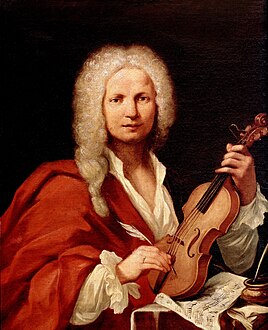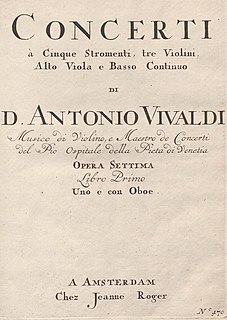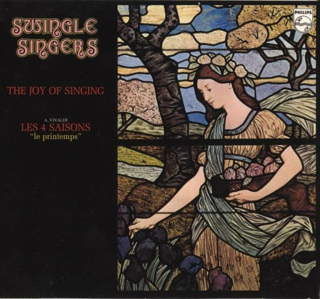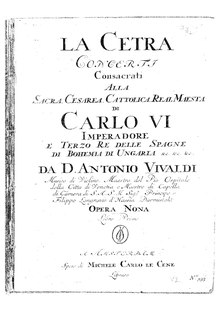
Antonio Lucio Vivaldi was an Italian composer, virtuoso violinist and impresario of Baroque music. Regarded as one of the greatest Baroque composers, Vivaldi's influence during his lifetime was widespread across Europe, giving origin to many imitators and admirers. He pioneered many developments in orchestration, violin technique and programatic music. He consolidated the emerging concerto form into a widely accepted and followed idiom, which was paramount in the development of Johann Sebastian Bach's instrumental music.

The Four Seasons is a group of four violin concertos by Italian composer Antonio Vivaldi, each of which gives musical expression to a season of the year. These were composed around 1718−1720, when Vivaldi was the court chapel master in Mantua. They were published in 1725 in Amsterdam, together with eight additional concerti, as Il cimento dell'armonia e dell'inventione.

L'estro armonico, Op. 3, is a set of 12 concertos for stringed instruments by Italian composer Antonio Vivaldi, first published in Amsterdam in 1711. Vivaldi's Twelve Trio Sonatas, Op. 1, and Twelve Violin Sonatas, Op. 2, only contained sonatas, thus L'estro armonico was his first collection of concertos appearing in print. It was also the first time he chose a foreign publisher, Estienne Roger, instead of an Italian. Each concerto was printed in eight parts: four violins, two violas, cello and continuo. The continuo part was printed as a figured bass for violone and harpsichord.
Hyacinthe Jadin was a French composer who came from a musical family. His uncle Georges Jadin was a composer in Versailles and Paris, along with his father Jean Jadin, who had played bassoon for the French Royal Orchestra. He was one of five musical brothers, the best known of whom was Louis-Emmanuel Jadin.

A set of twelve concertos was published by Estienne Roger in 1716-1717 under Antonio Vivaldi's name, as his Opus 7. They were in two volumes, each containing concertos numbered 1-6. Of the set, ten were for violin solo; the other two were for oboe solo. The authenticity of some of the works included has long been doubted by scholars. Three are now considered spurious for stylistic reasons. They are: No. 1 in B-flat major for oboe, RV Anh. 143 ; No. 7 in B-flat major for oboe, RV Anh. 142 ; and No. 9 in B-flat major for violin, RV Anh. 153.

La stravaganza [literally 'Extravagance'], Op. 4, is a set of concertos written by Antonio Vivaldi in 1712–1713. The set was first published in 1716 in Amsterdam and was dedicated to Venetian nobleman Vettor Delfino, who had been a violin student of Vivaldi's. All of the concertos are scored for solo violin, strings, and basso continuo; however, some movements require extra soloists.

Il Cimento dell′ Armonia e dell′ Inventione is a set of twelve concertos written by Antonio Vivaldi and published in 1725 as Op. 8. All are for violin solo, strings and basso continuo. The first four, which date back to 1718–23, are called The Four Seasons. The set was published in the Amsterdam workshop of Michel-Charles Le Cène and dedicated to Wenceslas, Count of Morzin, an advisor to Charles VI, Holy Roman Emperor.
An organ concerto is a piece of music, an instrumental concerto for a pipe organ soloist with an orchestra. The form first evolved in the 18th century, when composers including Antonio Vivaldi, George Frideric Handel and Johann Sebastian Bach wrote organ concertos with small orchestras, and with solo parts which rarely call for the organ pedal board. During the Classical period the organ concerto became popular in many places, especially in Bavaria, Austria and Bohemia, reaching a position of being almost an integral part of the church music tradition of jubilus character. From the Romantic era fewer works are known. Finally, there are some 20th- and 21st-century examples, of which the concerto by Francis Poulenc has entered the basic repertoire, and is quite frequently played.

The Best Classics... Ever! is a compilation album released by EMI in late 2005. This compilation contains both short works and excerpts from longer works by renowned classical composers.

The Joy of Singing, a.k.a.Les 4 Saisons is a 1972 album by the Swingle Singers on the Philips Records label. All tracks from this album are also included on the 11 disk Philips boxed set, Swingle Singers.

Antonio Vivaldi wrote a set of flute concertos, Op. 10, that were published c. 1728 by Amsterdam publisher Michel-Charles Le Cène.

Six Violin Concerti, Op. 6, is a set of concertos written by Antonio Vivaldi in 1712–1715. The set was first published in 1719 in Amsterdam.
- Allegro
- Grave
- Allegro
- Allegro
- Largo
- Allegro
- Allegro
- Adagio
- Allegro
- Allegro
- Adagio
- Allegro
- Allegro
- Largo
- Allegro
- Allegro
- Largo
- Allegro

Antonio Vivaldi wrote a set of concerti for violin, strings and continuo, Op. 12, in 1729.

Antonio Vivaldi composed several sonatas for cello and continuo. A set of six cello sonatas, written between 1720 and 1730, was published in Paris in 1740. He wrote at least four other cello sonatas, with two manuscripts kept in Naples, another in Wiesentheid, and one known to be lost.

L'arte del violino is a noteworthy and influential musical composition by Italian Baroque violinist and composer Pietro Locatelli. The twelve concerti were written for solo violin, strings, and basso continuo and were published in 1733 as the composer's third opus. The virtuosic style and artistry present in the work strongly influenced violin playing in the 18th century and cemented Locatelli's reputation as a pioneer of modern violin technique.

La tempesta di mare, a flute concerto in F major, is the first of Six Flute Concertos, Op. 10 by Antonio Vivaldi, published in the late 1720s. La tempesta di mare may also refer to two earlier versions of the same concerto, RV 98, a concerto da camera featuring the flute, from which Vivaldi derived the concerto grosso RV 570.

The organ concertos of Johann Sebastian Bach are solo works for organ, transcribed and reworked from instrumental concertos originally composed by Antonio Vivaldi and the musically talented Prince Johann Ernst of Saxe-Weimar. While there is no doubt about the authenticity of BWV 592–596, the sixth concerto BWV 597 is now probably considered to be spurious. Composed during Bach's second period at the court in Weimar (1708–1717), the concertos can be dated more precisely to 1713–1714.

Grosso mogul, also Il grosso mogul, or capitalised [Il] Grosso Mogul, RV 208, is a violin concerto in D major by Antonio Vivaldi. The concerto, in three movements, is an early work by the Venetian composer. Around the mid-1710s Johann Sebastian Bach transcribed the concerto for organ, BWV 594, in C major. A simplified version of the violin concerto, RV 208a, without the elaborated cadenzas that appear in manuscript versions of RV 208, and with a different middle movement, was published around 1720 in Amsterdam as concerto #11 of Vivaldi's Op. 7.

Antonio Vivaldi's Concerto for Two Trumpets in C major, RV 537, is a concerto for two trumpets, string orchestra and basso continuo in three movements, believed to have been composed in the 1720s. It is Vivaldi's only trumpet concerto. It was published by Ricordi in 1950 after its manuscript was found in a Turin library.













